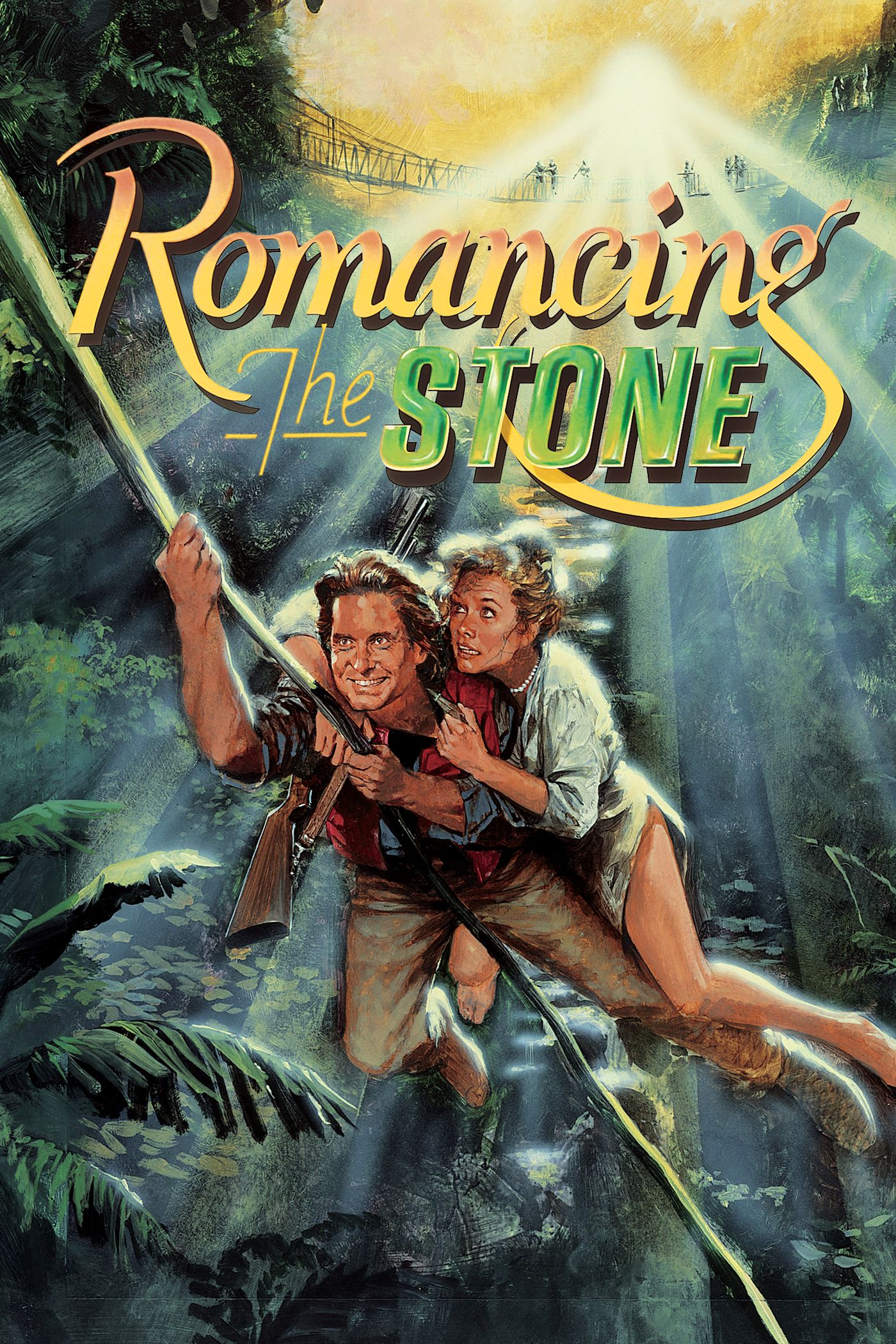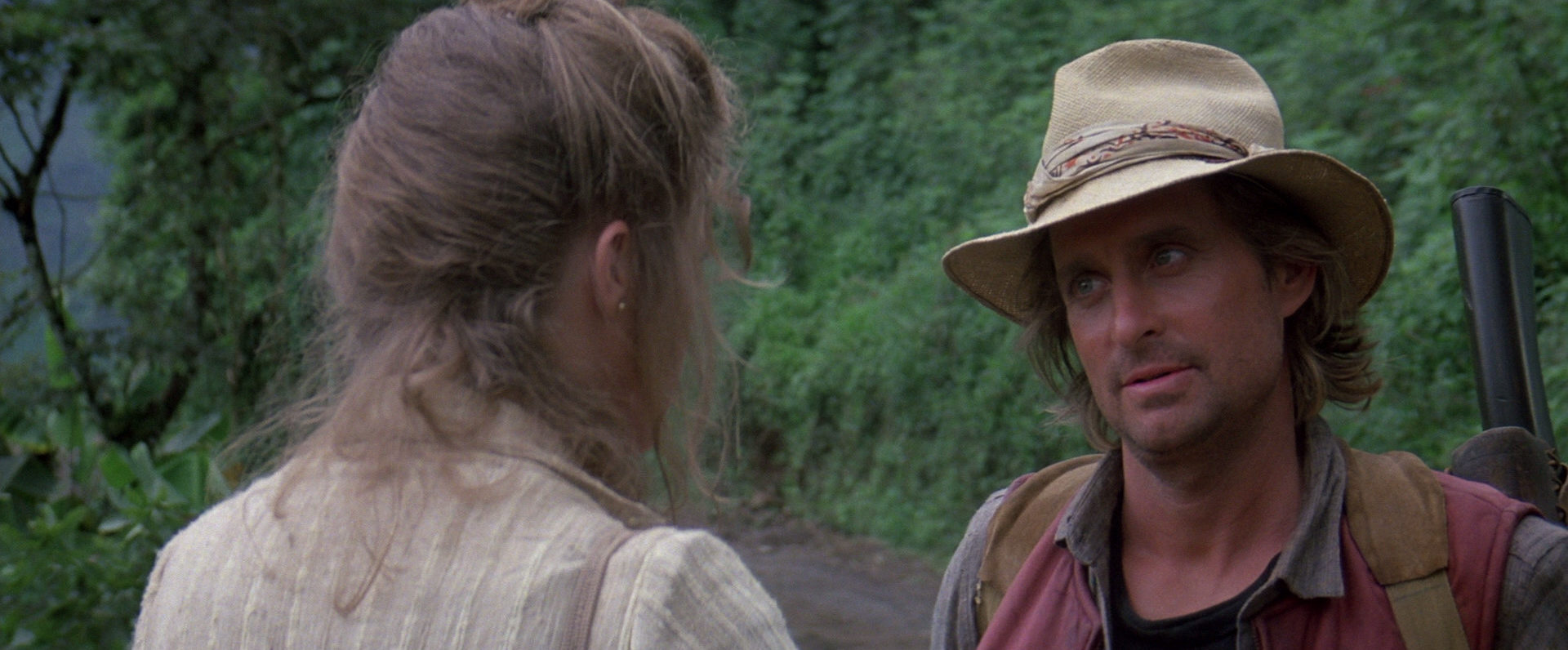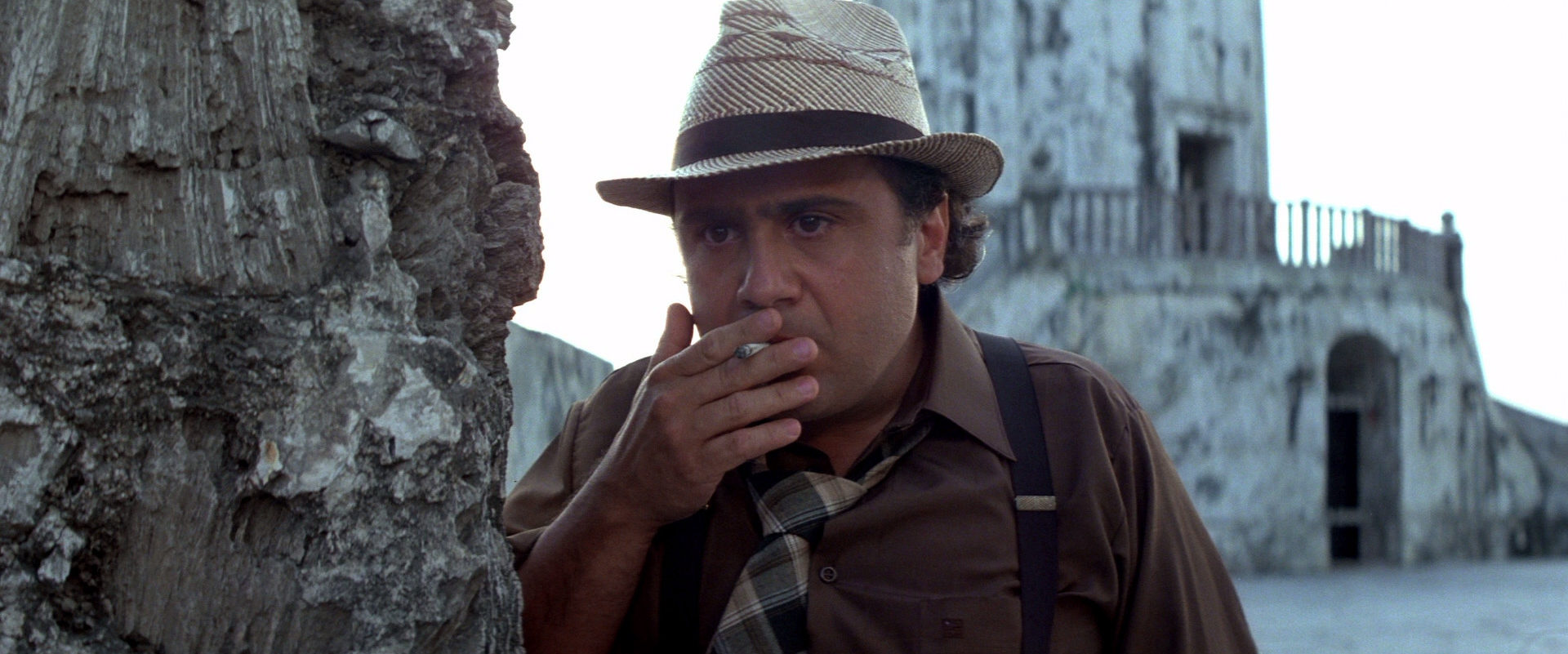

“My minimum price for taking a stranded lady to a telephone is four hundred dollars.”
If Romancing the Stone holds up—and I would argue that it does, quite well—it’s thanks to the witty and rip-roaring script from novice Diane Thomas, who tragically passed away less than a year after the film became a surprise hit.
Balancing and often combining rollicking action-adventure with romantic comedy, Robert Zemeckis’ Raiders of the Lost Ark–derived film stars Michael Douglas as bushwhacking bird smuggler Jack T. Colton alongside Kathleen Turner’s pulp romance novelist, Joan Wilder. Fate thrusts this unlikely couple together when Joan receives a treasure map in the mail, quickly followed by a frantic phone call from her sister (Mary Ellen Trainor) begging the metropolitan writer to travel alone to Columbia to deliver the accompanying parcel in exchange for her sibling’s life. Woefully ill-equipped to handle such an adventure but made confident by her pulp fantasy daydreams, Joan journeys from NYC to Columbia for the handoff.
As expected, things don’t go as planned. Joan soon finds herself stranded in the middle of the Columbian jungle with nothing but a suitcase full of useless clothes and a pair of high heels. Her dashing hero arrives just in time to rescue her from the clutches of Colonel Zolo (Manuel Ojeda), a commander of secret police forces who wants to get his hands on the map. So do Ira (Zack Norman) and Ralph (Danny DeVito), the antique smuggling cousins who hold Joan’s sister hostage and, like all good villains, keep hungry alligators close at hand.
As Jack chaperones Joan to Cartagena—for $375 in traveler’s checks, after negotiation—these factions repeatedly cross paths and get caught up in all sorts of contrived and humorous ways. At one point, Jack and Joan find themselves held at gunpoint by a drug smuggler (Alfonso Arau) until Jack sarcastically asks Joan to think of a good plot twist to get them out of the pickle and the bandito reveals that he is a huge fan of her work. At another, Ralph, who is wanted by Zolo’s forces but is tasked with tracking Joan’s movements, wakes up from slumbering in the back of his car to discover that Jack and Joan have hijacked it. There’s also a memorable scene where the two soon-to-be lovers find a crashed plane full of marijuana and use it to make a bonfire to warm up and dry out their clothes. And of course, once Jack realizes that his ward is carrying a treasure map, he starts having all sorts of ideas.

It’s that amiable texture—neither too serious nor too sinister; cheekily mixing low-stakes adventure with snappy screwball comedy; shamelessly exploiting spectacular car chases, silly gags, and nutty villains for max entertainment value and pure cinematic pleasure—that sets Romancing the Stone within the upper tier of ‘80s popcorn films. Like I said, most of this comes from the screenplay, but Zemeckis proves perfectly suited for the material and adds little flourishes in all the right spots. Somehow, he manages to provide mid-scale action sequences with adequate heft and energy while avoiding any real threat of danger (except for Zolo’s marvelously telegraphed run-in with a gator) and carving out enough elbow room for gratifying banter. Consider the sequence where Joan’s car crashes into a rushing river and she continues trying to steer it. Or the presence of a motor-mouthed Danny DeVito as a bumbling villain, completely in sync with the Looney Tunes–esque chaos of the proceedings.
At the center of the story is Joan’s personal journey from a lonely soul yearning for the perfect man, to a strong, independent go-getter who by virtue of her transformation finds true love. It’s not particularly sophisticated, but it provides enough of an arc to move things forward and allows Turner to cover a wide range of modes—distressed, confident, seductive, charming, funny. As her own life becomes increasingly entwined with the fictional worlds she has dreamed up with her typewriter, Joan gradually takes on the character traits that she associates with the rugged adventurers in her books. The turning point comes when she ignores Jack’s command for her to get behind him as Zolo’s paramilitary troops fire rifles at them. Instead, she tries to cross a rickety ravine-spanning bridge and ends up traversing the gap by swinging on a vine George of the Jungle style.

There’s certainly a lack of depth to the basic storyline; but as a cinematic enterprise Romancing the Stone is intricately layered with such precision that its intoxicating properties seem to emerge almost effortlessly. The large roster of distinct personalities is juggled with a breezy confidence and uplifted by the flirtatious ribbing between the two leads. Often, the transitional moments in a film like this will feel stale and insincere, but Turner and Douglas have such great chemistry that their amusing riffs threaten to outshine the elaborate chase sequences, which are themselves enriched by the believability of the interstitial repartees. Watching movies in a cynical era where blockbusters typically deliver little more than a show of special effects, Romancing the Stone feels fresh and joyful and full of personality. It was followed a year later by a sequel (The Jewel of the Nile) that returned both stars but neither screenwriter nor director, and, by contrast, is sufficient proof that Zemeckis and Thomas crafted something special here.